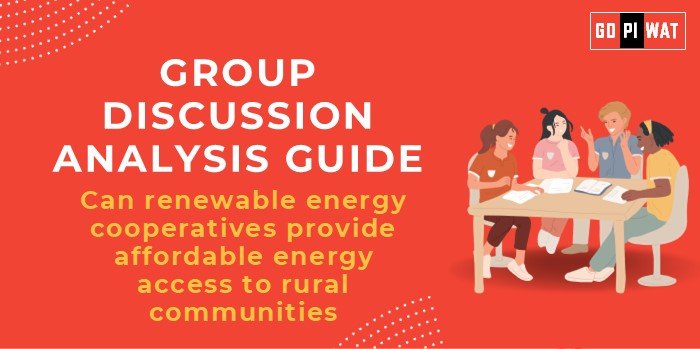📋 Group Discussion Analysis Guide
🌟 Introduction to the Topic
Opening Context: As global energy demands rise, renewable energy has emerged as a vital solution to combat climate change and promote sustainable development. For rural communities, energy cooperatives offer a promising model to enhance energy access while empowering local populations.
Topic Background: Renewable energy cooperatives are community-driven organizations that produce, manage, and distribute energy, prioritizing affordability and accessibility. Originating in Europe, their relevance is expanding globally, especially in regions where traditional energy systems are limited.
📊 Quick Facts and Key Statistics
- Global Renewable Energy Share: Renewables account for 30% of global electricity generation (IEA, 2024).
- India’s Rural Electrification: 99% village electrification, but 20% still lack reliable energy access (MNRE, 2023).
- Cost Reduction: Solar energy costs fell by 89% between 2010 and 2023 (IRENA, 2024).
- Cooperative Success: Over 2,000 energy cooperatives operate successfully in Europe, serving millions.
🧑🤝🧑 Stakeholders and Their Roles
- Government: Policy support, subsidies, and technical frameworks.
- Private Sector: Technology provision and funding.
- Communities: Ownership and operational management.
- NGOs and International Bodies: Capacity building and funding.
🏆 Achievements and Challenges
Achievements:
- Community Empowerment: Increased employment and local ownership in Europe.
- Affordability: Lower energy tariffs compared to private utilities.
- Sustainability: Reduction in carbon emissions by adopting green energy.
- Innovation: Microgrids and decentralized systems proving effective in Africa and Asia.
Challenges:
- Initial Investment: High upfront costs hinder adoption.
- Policy Gaps: Insufficient regulatory support in developing countries.
- Maintenance Issues: Technical expertise often lacking in rural areas.
Global Comparisons: Germany’s thriving cooperative model with 47% renewable energy share vs. Kenya’s success with off-grid solar cooperatives.
Case Study: Dharnai model in Bihar, India, showcases how solar cooperatives can transition villages to energy independence.
💬 Structured Arguments for Discussion
- Supporting Stance: “Renewable energy cooperatives democratize energy access, reduce costs, and promote sustainability, making them ideal for rural contexts.”
- Opposing Stance: “High initial costs, lack of technical expertise, and insufficient government policies can limit the scalability of energy cooperatives.”
- Balanced Perspective: “While renewable energy cooperatives face challenges, strategic partnerships and supportive policies can unlock their potential to revolutionize rural energy access.”
🗣️ Effective Discussion Approaches
- Opening Approaches:
- Start with a success story, like Dharnai village.
- Highlight stark statistics, e.g., rural access disparity.
- Counter-Argument Handling: Use data to address challenges, e.g., showcasing cooperative cost benefits.
🔍 Strategic Analysis of Strengths and Weaknesses
- Strengths: Decentralization, affordability, environmental benefits.
- Weaknesses: High setup costs, maintenance.
- Opportunities: Policy support, international funding.
- Threats: Market competition, policy instability.
📚 Connecting with B-School Applications
- Real-World Applications: Linking cooperatives to sustainability projects, impact investing, and energy finance.
- Sample Interview Questions:
- “How can renewable energy cooperatives bridge India’s rural energy gap?”
- “Evaluate the scalability of cooperatives in addressing global energy demands.”
- Insights for Students: Explore energy policies, assess cooperative models, and analyze their socio-economic impacts.


